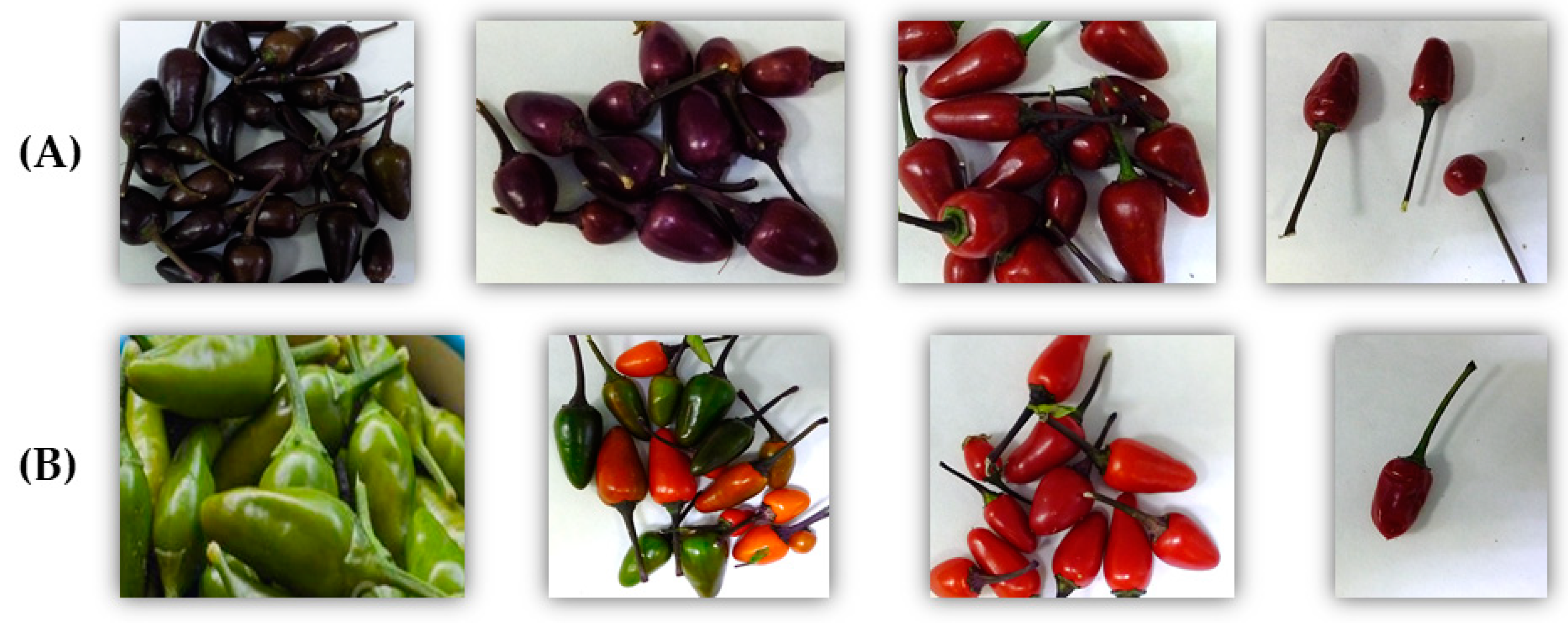Capsaicinoids and capsinoids, which are bioactive compounds of interest, are responsible for the level of pungency of chili peppers, which is one of their most important commercial traits. Both capsaicinoids and capsinoids have received great attention from consumers because of their extensive pharmacological and physiological effects, i.e., antitumor, antioxidant, antiobesity, anti-inflammatory, and analgesic.
- capsaicinoid, capsinoid, pepper
1. Introduction
The “Filius Blue” variety exhibited increasing concentrations of capsaicinoids up to the 41st day post-anthesis (dpa), from which point on this trend was reversed. The concentrations in the “Filius Green” variety increased and decreased several times, reaching maximum concentrations on the 69th dpa. Regarding capsiate contents, both varieties varied in the same way, reaching maximum concentrations on the 34th dpa and then decreasing.
Figure 1. Peppers are fruits with wide genetic variability and multiple ways of being consumed that hold a relevant position in the human diet. Nowadays, consumers are interested in new gastronomic experiences provided by pepper cultivars that present new shapes, colors, and flavors while preserving their bioactive compounds, such as their capsaicinoids and capsinoids. However, numerous changes take place during their development that may alter their biological properties.
2. Changes in Peppers’ Total Capsaicinoids Content
The two cultivars under study used to perform the experiments were grown in an automated and acclimatized greenhouse under controlled conditions. They began to produce peppers during the second week of July and they were harvested 11 weeks later, specifically on 30 September. They were monitored during the development of the pepper fruits, from the 13th until the 76th day post anthesis (dpa). The visual appearance of the peppers at the different development stages was registered and is presented in Figure 2.
Therefore, this work evaluates the capsaicinoid and capsiate contents in two traditional varieties of ornamental peppers (“Filius Blue” and “Filius Green’”) during fruit maturation. The aim is to determine the ideal harvesting moment depending on the farmer’s objective (e.g., achieving a specific color, shape, or flavor; achieving the maximum concentrations of bioactive compounds). The capsaicinoid contents followed different patterns in the two varieties analyzed. The “Filius Blue” variety exhibited increasing concentrations of capsaicinoids up to the 41st day post-anthesis (dpa), from which point on this trend was reversed. The concentrations in the “Filius Green” variety increased and decreased several times, reaching maximum concentrations on the 69th dpa. Regarding capsiate contents, both varieties varied in the same way, reaching maximum concentrations on the 34th dpa and then decreasing.

Figure 2. Changes in the color of the fruits in both varieties over their maturation process. (
. Changes in the color of the fruits in both varieties over their maturation process.
A) Purple variety ‘Filius Blue’; (
A) Purple variety ‘Filius Blue’;
B) green variety ‘Filius Green’. The images of each variety were taken at 13, 34, 55 and 76 dpa from left-to-right, respectively.
B) green variety ‘Filius Green’. The images of each variety were taken at 13, 34, 55 and 76 dpa from left-to-right, respectively.
3. Conclusion
The current work has demonstrated that pepper fruits from the varieties known as ‘Filius Green’ and ‘Filius Blue’ may undergo significant variations with regards to their content in the bioactive compounds that are responsible for pepper pungency, i.e., capsaicinoids and capsinoids. Such differences should be attributed to genotype intrinsic characteristics, since both varieties were grown in a greenhouse under the same controlled conditions. The ‘Filius’ varieties can be used for decorative and aesthetic purposes in foods and dishes due to their colorful fruits, for nutritional purposes and as a medicinal supplement because of their high content in capsaicinoids and capsinoids.
In this study, it has been seen that pepper fruit color experiences a number of changes over its ripening process, which have been analyzed in relation to the content of capsaicinoids and capsinoids throughout the fruit maturation. The possibility of eating peppers with similar hot sensations and different colors, as well as peppers of the same color with different pungency, which can be attractive to the consumer, has been observed. On the one hand, their optimal harvesting time should be determined by the fruit color in relation to the desired gastronomic application, which would be purple or green in the early stages of fruit development and red in the final stages. On the other hand, and considering their attractive biological activities exhibited by the compounds of interest that have been studied herein, when harvested for medical purposes, peppers should be collected at the moment when its bioactive content is the greatest or the pungent taste is the required. While both varieties analyzed follow the same trend for capsinoids accumulation and reach their maximum value on the 34th dpa, the content curve for capsaicinoids differs between the two varieties, so that the highest concentration levels were reached either on the 41st or the 69th dpa. C was the major capsaicinoid found in both varieties, followed by DHC, n-DHC, h-C, and h-DHC, and their content percentages hardly varied over the fruit maturation process. Based on the standardized values of each capsaicinoid, different patterns have been registered for h-C in comparison to the rest of the capsaicinoids
